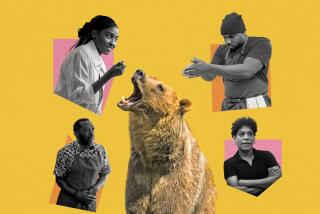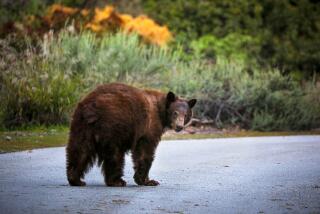Welcome to the World of Alaskaâs McNeil Falls Bears
Brown Bear Summer by Thomas Bledsoe (Truman Talley/Dutton: $18.95; 220 pages; illustrated)
If you are a fan of television wildlife specials, then you have almost certainly seen the brown bears of McNeil Falls, Alaska. They are the most photographed bears on the planet, and for good reason. At this accessible (by Alaskan standards) chunk of the Alaskan Peninsula, dozens of bears weighing up to half a ton congregate each summer to exploit rich runs of salmon on the McNeil and adjacent rivers.
A species fundamentally intolerant--not only of human beings but of its own kind--tolerates both in exchange for the fishy protein resources that help make McNeil bears among the largest of their kind. The state of Alaska has reserved this scenic reach of river for a limited quota of photographers who are privileged to witness and record the doings of an ordinarily wary and dangerous species in extraordinary circumstances.
First research on the McNeil bears began in the early 1960s: efforts by the Alaska Department of Fish and Game to tag and census a highly coveted population of trophy bears. In 1970, Utah State University undertook a pioneer project to learn something of the ecology and behavior of coastal brown bears (âUrsusarctosâ) in the McNeil drainage. Thomas Bledsoe was hired to record bear behavior for the summers of 1973-1975, after which time the project ended. His remarkable observations during those years and return visits are the basis of this book.
Secretive Animals
Bears are beguiling because while they can be large and dangerous, they are quite human in form, intelligence, food habits: our furry forest doppelganger. Although trapping and radio-telemetry have revealed a great deal of the biology of bears in the past 20 years, most behavior has been glimpsed through a glass darkly. Bears are asocial, secretive animals whose behavior in zoos or even in the wild when they are aware of people (i.e. nearly always) does not replicate their natural repertoire.
Bledsoe was doubly blessed in his study situation: Most of McNeil bears were habituated to humans and ignored them so long as they remained in the protected zone; although ordinarily disdaining their own kind, McNeil bears were forced to function socially within the limited confines of the salmon fishing areas. Bledsoe was able to observe natural behavior close-up; he became so familiar with his subjects that he could identify individuals without having to rely on the customary crutch of capture-and-mark.
What Bledsoe saw and reports here is wonderful stuff. The bears arrive each June and repeat the difficult process of getting along with one another.
After the necessary period of charges and mock fights and flights, the bears settle down to the business of catching fish. Some stand and swipe, some dive and bite, some lunge and thrash, and some simply steal from others. Mothers with new cubs must fish and watch out for the welfare of their tiny offspring in dangerous circumstances.
Disposes of Myth
Dominant bears get the best fishing holes . . . usually. But these bears are distinct individuals whose individual quirks became so familiar to Bledsoe that he permitted some bears to approach practically right beside him because he knew they posed no danger, while others had to be watched warily. He effectively disposes of the myth of the unpredictability of bears by showing it to be the variation among individuals. Bledsoeâs use of detail in describing behavior from play bouts to courtships is graphic and functional.
Ethological field research is composed largely of the counting and timing of behavioral events; it is only by building a large, systematic record that scientific insight can be gained.
Unfortunately, the recounting of such records does not make for a good read. Although Bledsoe hints at this effort by providing a few tables of such esoterica as encounter rates and dominance relationships, his book is largely an organized string of anecdotes.
âBrown Bear Summerâ is a book about bears, not about the adventures of a biologist. While you know what Bledsoe is doing while his subjects are eating, fighting, caring for their young, mating, playing, and posturing, his performances are strictly cameo. This is an admirable exercise in ego-restraint, but it poses a problem for this non-technical work: principal acting responsibility falls to the bears.
If you are a dedicated lover of bears and endlessly fascinated by their doings, this book is a gold mine. Otherwise, this may be more than you ever wanted to know on the subject.
Master biologists who are also masters of the popular genre, such Konrad Lorenz, Lewis Thomas, and Stephen Jay Gould, use their observations as object lessons in telling the grand tale of evolution and ecology, from which behavior derives. Although Bledsoe makes a few sincere stabs at sociobiological explanations for male dispersal, cub killing, adoption, and the high mortality rate of McNeil cubs, he is well out of his depth and I take issue with a number of his interpretations.
Bledsoeâs writing, while readable and unassuming, can be painfully sophomoric; he was not well served by his editor. He has, nonetheless, made an uncommon contribution to our understanding of bears.
More to Read
Sign up for The Wild
Weâll help you find the best places to hike, bike and run, as well as the perfect silent spots for meditation and yoga.
You may occasionally receive promotional content from the Los Angeles Times.






